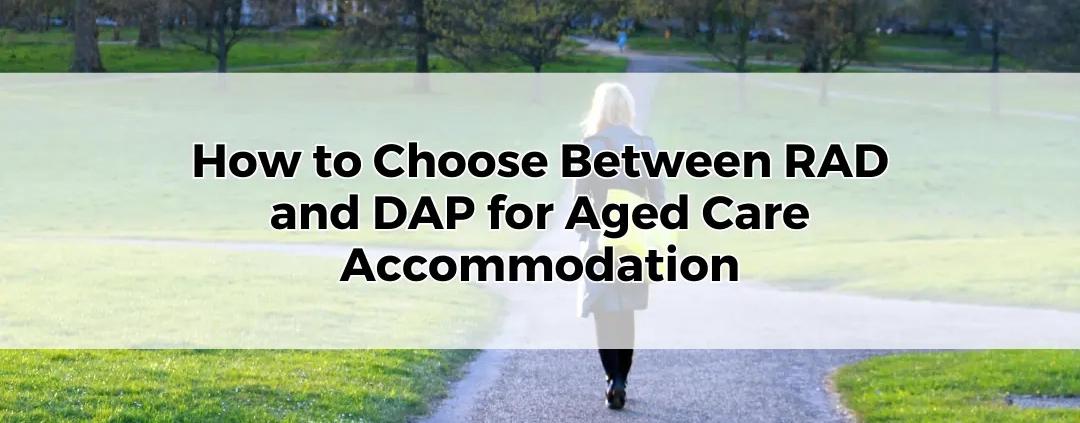How to Choose Between RAD and DAP for Aged Care Accommodation
Table of Contents
ToggleNavigating the financial landscape of aged care accommodation can be daunting. Costs vary widely and understanding the different payment options is crucial. Making an informed choice between a Refundable Accommodation Deposit (RAD) and a Daily Accommodation Payment (DAP) can significantly impact your financial health.
Choosing the right payment method for aged care accommodation is essential. It not only affects your current financial situation but also has long-term implications for your estate and overall financial well-being. It’s a decision that requires careful consideration and planning.
What is a Refundable Accommodation Deposit (RAD)?
Definition of RAD
A Refundable Accommodation Deposit (RAD) is a lump sum payment made to an aged care facility. It acts as a form of security and covers your accommodation costs. The RAD is fully refundable when you leave the facility, provided no outstanding fees are owed.
How RAD Works
When you opt for a RAD, you pay a one-time, upfront amount. This amount is held by the facility and earns interest, which is used to fund your care. The principal amount is returned to you or your estate when you leave the facility, minus any agreed-upon deductions.
What is a Daily Accommodation Payment (DAP)?
Definition of DAP
A Daily Accommodation Payment (DAP) is an ongoing payment made daily to cover your accommodation costs in an aged care facility. Unlike the RAD, the DAP does not require a large upfront payment and is instead paid periodically.
How DAP Works
The DAP is calculated based on the interest rate set by the government, applied to the equivalent RAD amount. You pay this amount daily, and it can be adjusted periodically. This option is suitable for those who prefer not to part with a large sum of money upfront.
Comparing RAD and DAP
Key Differences
The main difference between RAD and DAP lies in the payment structure. RAD requires a substantial upfront payment that is refundable, while DAP involves smaller, regular payments without an upfront commitment. Each option has its own financial implications and benefits.
Pros and Cons of Each Option
RAD can offer peace of mind with a large, refundable deposit and potential savings on daily fees. However, it ties up a significant amount of capital. DAP, on the other hand, provides flexibility and liquidity but can be more expensive over time due to ongoing payments.
Financial Considerations
Assessing Your Financial Situation
Before deciding between RAD and DAP, assess your current financial situation. Consider your available assets, income streams, and long-term financial goals. This assessment will help determine which option aligns best with your financial capabilities.
Impact on Cash Flow and Savings
Choosing RAD impacts your cash flow by tying up a large sum of money, but it can preserve your savings over time. DAP affects your cash flow differently, requiring ongoing payments that can be managed within your monthly budget. Understanding this impact is crucial for making an informed decision.
Benefits of Choosing RAD
Long-term Savings
Opting for a RAD can result in long-term savings. Since the RAD is a lump sum, it can reduce the overall cost of care by eliminating daily payment fees. Additionally, the refundable nature of RAD ensures that your capital is preserved.
Refundability and Security
One of the main advantages of RAD is its refundability. The initial deposit is returned to you or your estate, providing a sense of security. This makes RAD a preferred choice for those who want to ensure their funds are safeguarded.
Benefits of Choosing DAP
Flexibility in Payments
DAP offers flexibility, allowing you to manage your finances without committing a large sum upfront. This option is beneficial if you prefer to keep your assets liquid and available for other uses.
No Large Upfront Cost
With DAP, you avoid the need for a significant upfront payment. This can be particularly advantageous if your financial resources are tied up in non-liquid assets or if you prefer to maintain cash flow for other investments or expenses.
Hybrid Option: Combining RAD and DAP
How the Hybrid Option Works
The hybrid option allows you to split the accommodation cost between a RAD and a DAP. This approach provides a balance, offering some of the benefits of both payment methods. You can decide the proportion of the RAD and DAP based on your financial situation.
Benefits of a Split Payment Approach
Combining RAD and DAP provides flexibility and security. It allows you to minimise daily payments while not committing all your funds upfront. This option can be tailored to your financial needs, providing a customised solution for aged care accommodation.
Case Studies
Example Scenarios for Choosing RAD
Consider an individual with substantial liquid assets who prefers to secure their accommodation costs upfront. By opting for a RAD, they preserve their estate’s value and benefit from lower daily fees. This option suits those who prioritise financial stability and long-term savings.
Example Scenarios for Choosing DAP
Imagine a retiree with most of their wealth tied up in property. They might prefer DAP to avoid liquidating assets. Regular payments fit their income flow from pensions and investments, offering flexibility without a large upfront commitment.
Impact on Government Benefits
Pension Implications
Your choice between RAD and DAP can impact your eligibility for government pensions. RAD is considered an exempt asset under means testing, potentially preserving pension benefits. DAP payments, being treated as income, might affect your pension entitlements.
Means Testing Considerations
Understanding how RAD and DAP affect means testing is crucial. RAD can help maintain eligibility for benefits, while DAP might increase assessable income, affecting your overall financial assistance. Consulting with a financial adviser can clarify these implications.
Seeking Professional Advice
Importance of Financial Planning
Choosing between RAD and DAP is a significant decision that benefits from professional financial planning. A financial planner can help assess your financial situation, provide projections, and guide you towards the most suitable option for your needs.
Finding a Qualified Adviser
Look for a qualified financial adviser with experience in aged care planning. They can offer personalised advice, helping you navigate the complexities of aged care costs and ensuring you make an informed decision that aligns with your financial goals.
Making the Final Decision
Steps to Take Before Deciding
Before making your final decision, review your financial situation, understand the implications of each option, and consult with professionals. Consider trialing the hybrid option to see how it fits your needs.
Long-term Implications
Remember, the choice between RAD and DAP has long-term implications. It affects your cash flow, estate planning, and financial security. Make sure to review your decision periodically to ensure it continues to meet your evolving financial situation and needs.
Choosing between RAD and DAP for aged care accommodation is a critical decision that requires thorough understanding and careful consideration. By evaluating your financial situation, understanding the benefits and implications of each option, and seeking professional advice, you can make a choice that ensures financial stability and peace of mind for your future.









